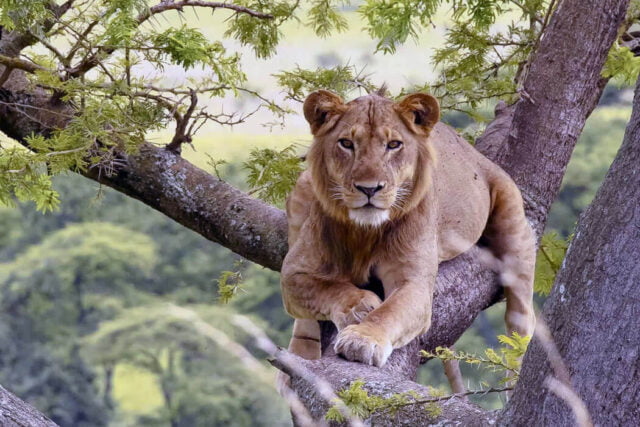Tree climbing lions are populations of lions that for some reason spend much of their lazy time up some trees, unlike their counterparts which prefer the ground. The tree climbing lions of Ishasha are one of Uganda’s rare wildlife encounters.
The lion is probably the most feared and respected of all African wild animals. This is because it is a super predator that is capable of hunting most of the savannah wildlife for food. Tree climbing lions are probably one of the least understood of the big cats. They are like all the other lions in every respect, except for tree climbing.

The normal behavior of a lion – regarding trees is that they lay under them for shade and to observe their prey. This is why it is very strange for lions to climb trees. In the whole world, there are two ‘populations’ of tree climbing lions – and only found in East Africa.
Tree climbing lions can be found in the Ishasha sector of Queen Elizabeth National Park of Uganda and in Lake Manyara National Park of Tanzania. For this reason, some people refer to these lions as the tree-climbing lions of East Africa.
Lions in Other parts of Africa such as Kluger and some parts of Kenya and Kidepo National Park have been seen climbing trees on very rare occasion.
Why Tree climbing lions Climb
There are two assumed reasons to explain why these lions have adapted to climbing trees. To avoid irritations by insects and bugs on the ground and to escape the Savannah heat by basking on the branches where they can get some fresh breeze. These reasons are further supported by the fact that these tree climbing lions stay on the ground in the night and when it rains – both situations that eliminate insects, bugs and the heat.

While the above reasons might be speculative, there is no denying the fact that basking in the trees helps them to keep watch over their prey. Common prey is usually the grazing wildlife such as antelopes, buffaloes and other such ‘lion food’.
Their tree-climbing skills are regarded as a behavioral adaptation that they have mastered so well and are able to teach even their young cubs. This is why they do it with practice majesty.
They are such a rare species in that there is no data or research out there, the only way for you to witness this is by visiting the three countries. The King of the jungle is not generally known or biologically structured for this. The bizarre and yet natural way they get up on the branches and hug them to rest is a sight to behold.
Where You Can See Tree Climbing Lions
Tree climbing lions can be found in Uganda and Tanzania. A chance encounter could be spotted anywhere on African Safari, but a guaranteed encounter is only in Lake Manyara National Park of Tanzania, and Uganda’s Queen Elizabeth National Park.

In Uganda, Queen Elizabeth National Park is the place for you to see these rare tree climbing lions. Visitors who take time to check out the Ishasha region have the opportunity to see more than 50 lions ‘lounging’ all day long in the acacia trees found in this particular region.
They are a little hard to spot at the start, considering the skin color and the trees in this area. However, with the help of your tour guide, you can spot them lying lazily on the tree branches either napping or staring out in the wilderness. It is quite an amazing site to watch the ‘big cat’ hanging from the trees.
The Uganda kob is very common in Ishasha sector and is the most common prey (food) that these lions eat. The trees over a great vantage point for the lions in regard to hunting for food.
Conservation
The number of climbing lions is dangerously reducing. The biggest threat to these tree climbing lions (and all lions in general) is humans. For example, in April 2018, 11 lions were found dead in the Ishasha sector of Queen Elizabeth N.P, Uganda – as a result of poisoning.

Among the reasons humans continue to threaten lions is encroaching on the national parks for agricultural land, poaching, hunting and illegal wildlife trade. The responsible bodies do a lot of work to stop poaching and encroachment but such efforts success depend on so many factors working together in perfect harmony.
The best approach to conservation in Uganda so far has been the working together of various stakeholders with the local communities towards a singular conservation goal. While this is yet to achieve full success for the tree-climbing lions, the work continues and we all hope for better conservation outcomes.
Conclusion
The curiosity about the tree climbing lions is not about what they eat, or how their social structures are organized but why they are different from their fellow lions. They share the same social, physical, dietary and re-population characteristic with all the other lions in the wild.
The suggestions on why they climb up the tree are not really confirmed (as earlier stated). This is for the obvious fact that lions are dangerous and the most you can do in terms of research is monitoring from a very safe distance. Be that as it may, tree-climbing lions are a fascinating sight to see – as they carry their heavy bodies up the tree with easy and practiced grace.
Being able to see the tree-climbing lions in Ishasha adds so much to a visitors experience of Queen Elizabeth National Park. It is common that while you are still in Queen Elizabeth National Park, you will go a for a game drive to see all the other animals, take a boat ride on Kazinga channel, track some chimpanzees and other primates as well as track the tree-climbing lions.
If you are planning on going on a Ugandan wildlife safari, make sure to have Ishasha lions as part of your tour program. The experience is great and we highly recommend taking the time to enjoy it in person.
Here are some Safari programs that include tracking these tree-climbing lions of Ishasha as well as other related activities. These can serve as a good inspiration for you. Just remember that all Safari Packages by Exclusive African Safaris can be customized to your liking, schedule and budget for free.
Finally, thank you for spending this time with us (albeit virtually). We hope this article was helpful to you. That is why we spent the time to create it – for you.
We would absolutely be thrilled if you shared this article with your online community on social media (or other media) such that more people will easily find it in future. No pressure.








